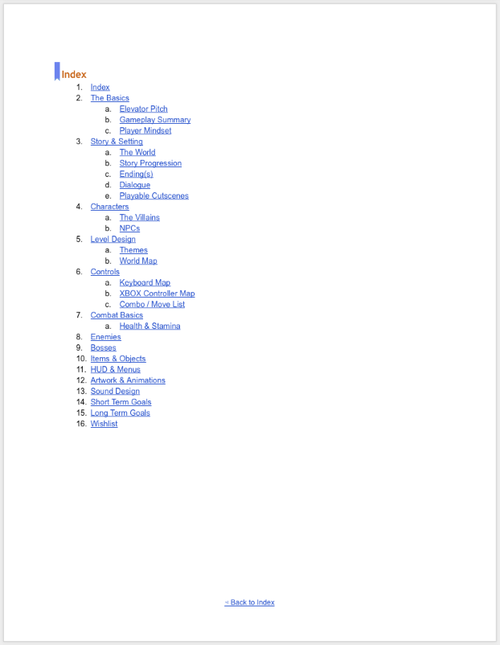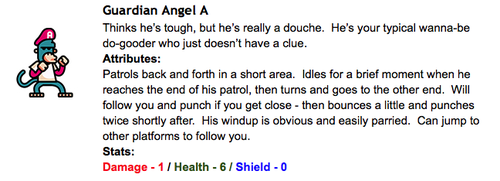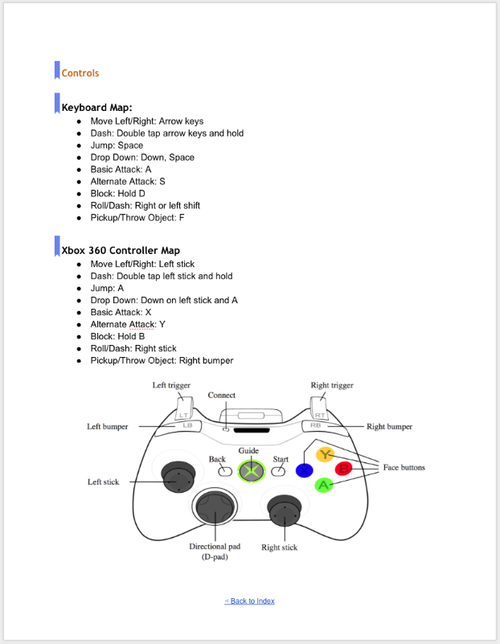Creating a Game Design Document: the Sooner, the Better
If you’re working on a large scale game, one of the most important things you can do is keep an organized GDD. Here's some tips, examples, and links to templates to get you started.

If you're working on a large scale game, one of the most important things you can do is keep an organized GDD. (Especially when you're working with a team!) We come up with so many little ideas for our current project, King Dudeman, over drinks, group texts, and random notepad entries and it's easy to let these thoughts slip through the cracks if there isn't a proper place to store them. We had e-mails dated back to 2010 to sort through when we started writing our GDD!
We like to collaborate using Google Docs. You can find a great starting template here. First, we made an index with bookmarked links to allow everyone to jump from topic to topic quickly. Here's a quick look at our current GDD index.

In the past we've made small, simple games without much of a story or a large cast of characters. All our games were also incredibly easy to control, mostly using a one or two gestures to control the game. However King Dudeman will have full controller support, rich combat mechanics, and a unique setting exploring several different worlds. To keep the whole team on the same page, it's important that we put it all on paper. It's easy to forget that your fellow devs can't read your mind, and the imagery you have planned might not make sense to them right away.
If you're in the early stages of development, these points should be your main focus:
Elevator Pitch
Everyone on your team should be able to explain what your game is all about in under 2 minutes, and you want the listener to understand what you're going for right away. Practice this on your friends and see if it makes sense without showing them any screenshots, or comparing your game with similar titles. This is crucial for talking about your game with fans, press, and potential investors.
Flow of Gameplay
Think about how the player will go from one level to the next, or if there will even BE levels. Are there bosses? A world map? Try to create a timeline of the entire experience and build on it as you go. Like your pitch, this is a critical element that you should be able to discuss clearly with everyone.
Level Design Themes and Characters
These don't need to be set in stone, but you want to start figuring out the vibe of your world and the characters who live there as soon as possible. Otherwise there's nothing for your art guy and sound dude to reference! Make sure to include links to inspirations where appropriate. "Cyber-punky" may not mean the same thing to everyone.
Also, add some flavor text whenever you can. It's fun, and it can be helpful when creating the artwork.

Controls
We're prototyping using keyboards, but we know that we'll eventually want to play King Dudeman with a controller. We started mapping it out early to help us think about how combos will work, and what actions should be assigned to each button.

Short Term & Long Term Goals
Think about what you want to accomplish over the first 3 months of development. Which mechanics do you want to focus on first? For King Dudeman, we want to create a demo level that shows off the combat, several enemy types, and a mini-boss fight. To do this, we need sprite maps and animation details for each character, background art, sound effects, music... and that's just the assets!
Long term goals can include dev salaries, licenses you may need, marketing plans and the actual release. Are you crowd-funding your game? Keep a list of ideas for a Kickstarter campaign so you have something to work off of when the time comes. Make sure to think about what your budget might look like throughout the early stages of development, and keep your project realistic.
We even made a wishlist of all the crazy ideas we'd like to see in the game if we had unlimited time and money. Ya never know!

Lastly, assign someone to be the GDD Master. It's easy for your document to spin out of control when several people are making edits and listing all their ideas at once. Invite your team to leave comments and ask questions, and once you've worked it out, have the project manager resolve those in the doc.
Also, don't be shy about sharing your GDD with close friends and peers. It's important to get feedback on your project early on, and to make sure that you're creating a fluid, coherent document that will benefit the entire project!
To read more about Piasa Games and what we do, visit us at piasagames.com
And follow us @piasagames
Read more about:
BlogsAbout the Author(s)
You May Also Like













